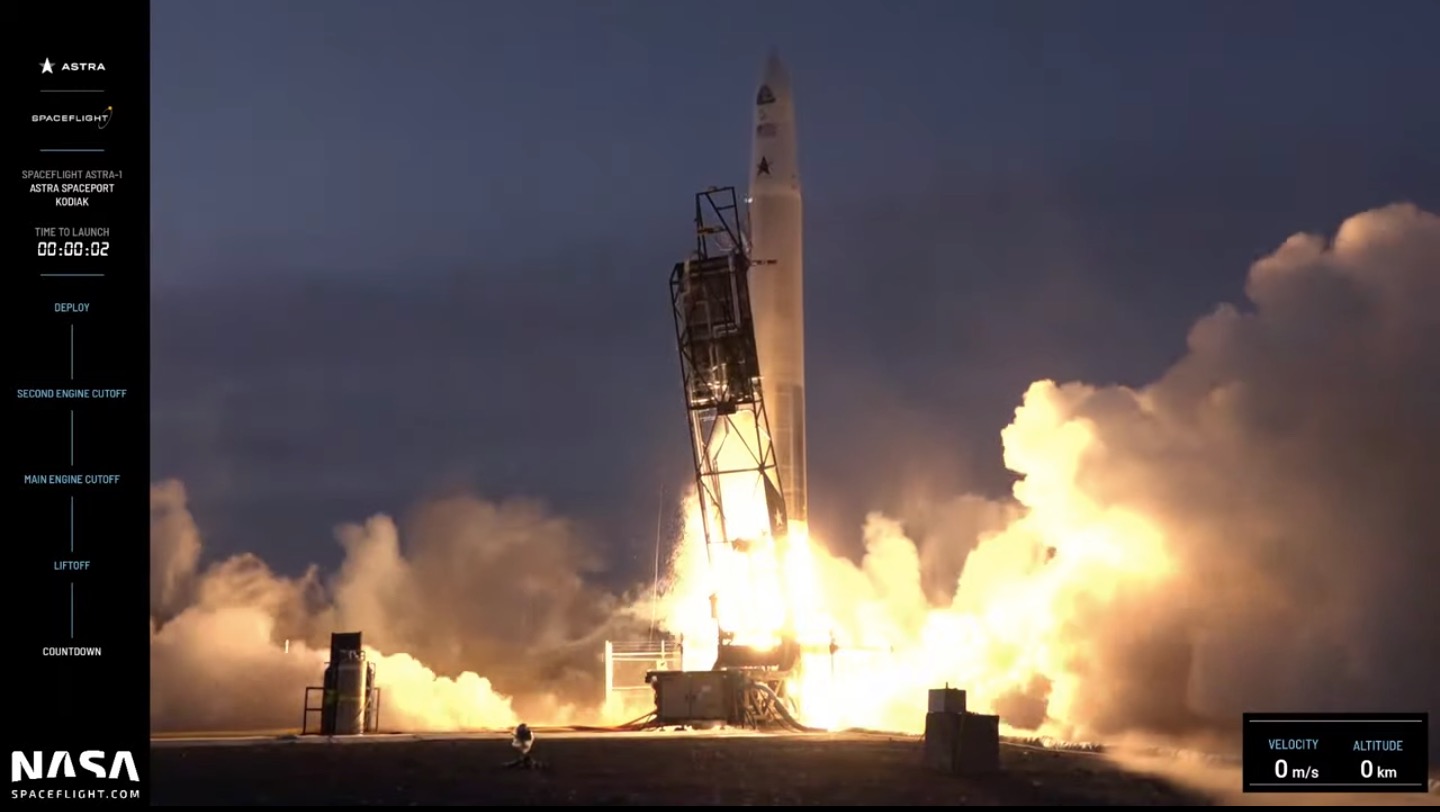
Astra bounced back from last month's launch failure with a groundbreaking success, deploying satellites in Earth orbit for the first time ever.
The California company's two-stage Launch Vehicle 0009 (LV0009) lifted off from the Pacific Spaceport Complex on Alaska's Kodiak Island today (March 15) at 12:22 p.m. EDT (1622 GMT; 8:22 a.m. local time on Kodiak). Just less than nine minutes later, the 43-foot-tall (13 meters) rocket deployed its payloads into their designated orbit, 326 miles (525 kilometers) above Earth.
It was a huge moment for Astra, which suffered a failure last month during its first-ever launch with operational payloads onboard.
"The flight was nominal," Astra co-founder, chairman and CEO Chris Kemp said in a livestreamed mission update about an hour after liftoff. "We couldn't be more excited to continue to deliver for our customers."
Video: Watch Astra's Rocket 3.2 launch on its 1st successful flight
Astra aims to break into the small-satellite launch market in a big way with its line of cost-effective, easily transported and ever-evolving rockets. The company had conducted five orbital flights before today, four of them test missions from Kodiak.
Astra reached orbit successfully on the most recent of those four test flights, a November 2021 mission that carried a non-deployable dummy payload for the U.S. Department of Defense. But the company stumbled on its next mission, its first with operational payloads onboard.
Get the Space.com Newsletter
Breaking space news, the latest updates on rocket launches, skywatching events and more!
That flight, which carried four tiny cubesats for NASA's Educational Launch of Nanosatellites initiative, lifted off from Florida's Cape Canaveral Space Force Station on Feb. 10. Astra's LV0008 performed well initially but encountered two problems about three minutes into the flight, when its first and second stages separated.
LV0008's payload fairing — the protective "nose cone" that surrounds satellites during launch — didn't deploy properly on Feb. 10, and the rocket's second stage began tumbling shortly thereafter. LV0008 couldn't recover from the latter issue, and the satellites were lost.
Astra investigators soon got to the bottom of both problems, tracing the fairing issue to an erroneous wiring diagram and the tumble to a software snafu. The company instituted fixes, clearing LV0009's path to the pad on today's mission, which was managed by Spaceflight, Inc.
LV0009 rose into the Alaska sky smoothly and ticked off its early milestones as planned. Stage separation and fairing deploy went well, and the rocket's second stage cruised to the desired orbit with no apparent issues.
LV0009 deployed its payloads successfully about nine minutes after liftoff, though we didn't get the good news until Kemp's postlaunch update. The mission's customers called Astra, confirming that their payloads were in communication with ground stations, he said.
It's not clear how many satellites deployed today; Astra and Spaceflight have disclosed two of the mission's payloads, but there were apparently more.
One of the known payloads is OreSat0, a tiny cubesat built by students at Portland State University in Oregon that is designed to serve as a testbed for future cubesats that will study Earth's climate and provide STEM (science, technology, engineering and math) outreach opportunities.
The other one we know about is NearSpace Launch's S4 Crossover, which is a technology demonstrator as well. S4 Crossover's main goal is "to obtain flight heritage testing for a prototype payload host platform," Astra representatives wrote in a description of today's mission. Unlike OreSat0, S4 Crossover did not deploy; it was designed to stay attached to LV0009's upper stage and will operate until the rocket body falls back to Earth, which is expected to happen in a few weeks.
Today's launch was originally supposed to happen yesterday (March 14), but bad weather forced a one-day delay.
Mike Wall is the author of "Out There" (Grand Central Publishing, 2018; illustrated by Karl Tate), a book about the search for alien life. Follow him on Twitter @michaeldwall. Follow us on Twitter @Spacedotcom or on Facebook.
Join our Space Forums to keep talking space on the latest missions, night sky and more! And if you have a news tip, correction or comment, let us know at: community@space.com.

Michael Wall is a Senior Space Writer with Space.com and joined the team in 2010. He primarily covers exoplanets, spaceflight and military space, but has been known to dabble in the space art beat. His book about the search for alien life, "Out There," was published on Nov. 13, 2018. Before becoming a science writer, Michael worked as a herpetologist and wildlife biologist. He has a Ph.D. in evolutionary biology from the University of Sydney, Australia, a bachelor's degree from the University of Arizona, and a graduate certificate in science writing from the University of California, Santa Cruz. To find out what his latest project is, you can follow Michael on Twitter.









